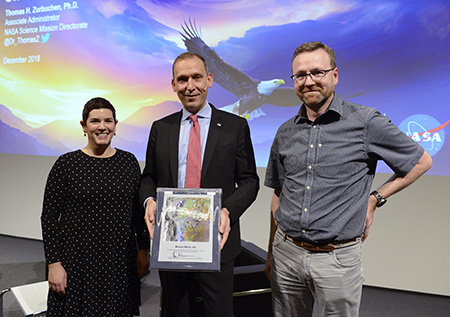NASA’s Rover Heads to the Red Planet With maxon drives
In July, NASA will be sending its fifth rover to Mars. Its main mission is to collect soil samples that will be analyzed on Earth at a later time. The rover will also carry a helicopter that will perform the first flights on the Red Planet. maxon's precision DC and BLDC motors will be used for numerous mission-critical tasks.
maxon drive systems are very familiar with Mars. Our drives have been used in virtually every successful robotic mission over the last three decades. There are now more than 100 of them on the Red Planet and there are likely to be more soon. The launch window for NASA's next mission opens on July 22nd. An Atlas V rocket will launch the new Perseverance rover on its way to Mars, where it will be searching for signs of previous life on the planet. Its most important job is to take multiple soil samples, seal them in containers, and deposit them on the surface of Mars so that a future mission can return them to Earth. Several maxon motors will be used to handle the samples inside the rover. For example, maxon DC motors are installed in the robotic arm, which moves the samples from station to station. Maxon motors will also be used for sealing and depositing the sample containers.
NASA's Jet Propulsion Laboratory (JPL) is carrying out the mission and has asked maxon to produce 10 drives for the rover. As with almost all previous Mars missions, these drives are based on standard products from maxon's catalog with modifications. For the first time, NASA is using brushless DC motors, including nine EC 32 flat and one EC 20 flat in combination with a GP 22 UP planetary gearhead. Working closely with JPL specialists, maxon engineers developed the drives over several years and tested them thoroughly to achieve the highest standards of quality.
"We've learned a lot from this exciting project," says Robin Phillips, head of the maxon SpaceLab. "We now have very broad expertise in space applications and have established quality assurance processes that meet the expectations of the industry. Customers from other industries such as the medical sector, where requirements are often similar, can also benefit from this know-how." Space missions place the highest demands on drive systems. This includes vibrations during the rocket launch, vacuum during the journey, impacts on landing, and the harsh conditions on the surface of Mars, where temperatures fluctuate between -125 and +20°C and dust penetrates everywhere.
The Perseverance rover is expected to land on Mars on February 18, 2021—but it won't be alone. A drone helicopter called Ingenuity will be attached to the underside of the rover. It weighs 1.8 kg, is solar-powered, and will perform several short flights, as well as take aerial images. The main goal of this experiment is to test the concept for further drones of this kind. maxon has six brushed DCX motors with a diameter of 10 mm controlling the tilt of the rotor blades and the direction of flight. The drives are very light, dynamic, and highly energy-efficient. These properties are crucial because every gram counts on the Mars helicopter.
Thomas Zurbuchen (center), research director at NASA, presents members of the maxon SpaceLab with a plaque of appreciation for their contributions to the Mars2020 mission. © maxon
Flying on Mars is not easy. The atmosphere is extremely thin, roughly comparable to the conditions on Earth at an altitude of 30 km. The drone helicopter has flown in a simulated test environment in the JPL laboratory. Whether it will lift off on Mars remains to be seen. First, other obstacles, such as the rocket launch, must be successful. "We hope that everything goes well and that we'll soon see our drives in action on Mars," says maxon CEO Eugen Elmiger. "We're all keeping our fingers crossed."
Image 2:
Left: The EC 20 flat with GP 22 UP gearhead.
Center: The modified EC 32 flat drive, nine of these drives are used in the Perseverance rover.
Right: DCX 10 motors used to control the tilt of the rotor blades in the Mars helicopter. © maxon

